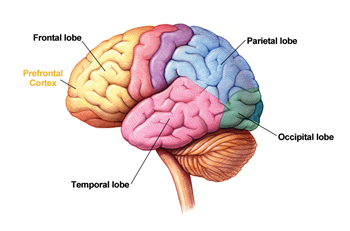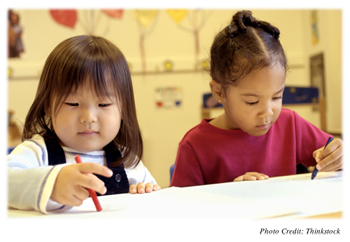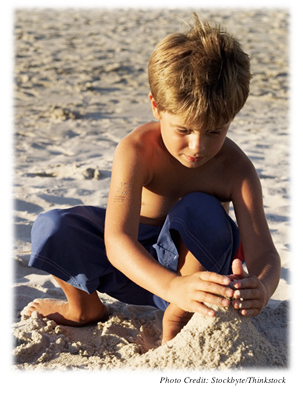

Chapter 1. Brain Development: Early Childhood
Synopsis

Brain Development: Early Childhood

Author
S. Stavros Valenti, Hofstra University
Synopsis
In this activity, you will observe illustrations and animations of critical brain development during early childhood (ages 2 through 6), including myelination and a process known as hemispheric lateralization, which is the developing coordination of the left and right hemispheres of the brain. The activity ends with a discussion of the impact of these brain developments on children’s growth and maturity during early childhood.
REFERENCES
There are no references for this activity.
The Young Child’s Brain

Brain growth is not as rapid during early childhood as it was during infancy, but critical changes do occur during early childhood that allow more rapid thought, more coordinated behavior, and better planning and goal setting. These abilities allow a child to acquire speaking fluency, better control of posture and movement, fantasy play, and effective problem-solving.
Macroscopic Brain Changes: Slowing Down the Brain Expansion

The rapid growth of the brain continues beyond birth up to the second birthday by which time the brain has attained 80 percent of its adult size. Most of this growth is due to the increase in dendrites and synaptic connections. Synapses are removed (synaptic pruning) as the brain becomes more fine-tuned, but overall, more synapses are added than are removed.
After the second birthday, the brain grows more slowly in size due to the closing of the gaps (sutures) between the separate skull parts. This growth process concludes between ages 6 and 8.
Play the animation to watch the brain grow in step with the enlargement of the infant’s head. Notice the sutures fusing between ages 6 and 8.
Myelination: A Sign of Brain Maturation
The process of myelination is largely complete by a child’s third birthday, but it continues at a much lessened pace through childhood, adolescence, and beyond. Myelination occurs when a fatty insulation (myelin) grows on the connecting fibers between neurons allowing for faster and more efficient communication within the brain. When brain researchers talk about “white matter,” they are referring to myelinated nerve bundles. When researchers talk about “gray matter,” they are referring to the unmyelinated brain cell bodies.
Myelination: The Corpus Callosum

One brain area that grows and rapidly myelinates during early childhood is the corpus callosum, a band of fibers that connects the left and right sides (hemispheres) of the brain. Because children do not have a mature corpus callosum during early childhood, the two sides, or hemispheres, of the brain do not communicate as well as they will after the brain matures a bit more. This lack of coordination of the cerebral hemispheres during early childhood is one reason why some of the behaviors of young children appear clumsy, wobbly, and slow.
1.
2. What is an example of an early childhood behavior that is attributable to poor hemisphere coordination?
Myelination: The Prefrontal Cortex

The prefrontal cortex is the last part of the human brain to fully myelinate and to reach maturity. The term prefrontal means “in front of the front.” It is the very front part of the brain’s outer layer known as the cerebral cortex. The prefrontal cortex is critical for reflective thought, planning, and control of impulsive behavior. At age 3 or 4, myelination that occurs in the prefrontal cortex allows for better impulse control and improvements in the ability to sustain attention, both of which are necessary for formal education to begin.
Heightened Brain Activity

Given the high levels of brain growth during early childhood, it may not surprise you that a preschool child’s brain uses a tremendous amount of energy. The young child’s level of brain activity is near its peak, and the brain metabolizes nutrients at a higher-than-adult level until the child reaches age 10 or so. After that time, brain activity steadily declines until about age 20. This increase in brain metabolism during early childhood may reflect a highly active process of remodeling of synaptic connections as well as myelination of areas critical for reflective thinking, planning, and impulse control.
Final Thoughts

Although the brain has matured in important ways, the brain in early childhood is still relatively immature. It is no surprise that children at this age are full of ideas and questions, but they are not quite ready for school. As you can well imagine, experience as well as brain maturation are necessary for the young child to sit in one place for an hour, to scan a page of print, to listen and think before talking, to remember important facts for more than a few seconds, and to control impulse and emotional behavior.
Assessment: Check Your Understanding

2.
1. After a child’s second birthday, the brain grows rapidly in size only to be limited by the closing of the sutures of the skull that occurs between the ages of 6 and 8 years.
Assessment: Check Your Understanding

3.
2. Faster and more efficient communication within the brain is the result of:
Assessment: Check Your Understanding

4.
3. The part of the brain that is critical for reflective thought, planning, and control of impulsive behavior is the prefrontal cortex.
Assessment: Check Your Understanding

5.
4. When young children appear clumsy, wobbly, and slow, it is often a result of the slow maturity and development of the:
Assessment: Check Your Understanding

6.
5. How does myelination in the prefrontal cortex help a child prepare to go to school?
Congratulations! You have completed this activity.Total Score: x out of x points (x%) You have received a provisional score for your essay answers, which have been submitted to your instructor.